
When you think of a European luxury guided tour, unusual architecture won’t be at the top of your list – it’s likely that famous landmarks such as the Eiffel Tower in Paris, Buckingham Palace in London and St. Peter’s Basilica in Rome spring to mind first. While these are all worthy destinations in their own right, over-tourism can be an issue, so we’re choosing to highlight places where your tourist dollar can provide support. This is part of our commitment to more sustainable travel options that travelers are seeking.
Many travelers are keen to learn the stories behind some of the world’s most fascinating buildings, and how they were dreamt into existence. Innovative and interesting design is a magnet for art lovers, engineers, and those with a discerning eye. Luckily visitors to Europe are spoiled for choice, from ancient religious monuments to futuristic masterpieces in every grand city.
Luxury Gold travelers have the opportunity to delve deeper into a destination, with VIP experiences to beautiful architectural landmarks such as the Schönbrunn Palace. If you have a passion for architecture, be sure to inform you Traveling Concierge so they can further shape your journey to suit your tastes and identify point of interest along the way. Now, let us ignite your imagination and introduce you to the most unusual architectural marvels in Europe.
The Dancing House, Prague
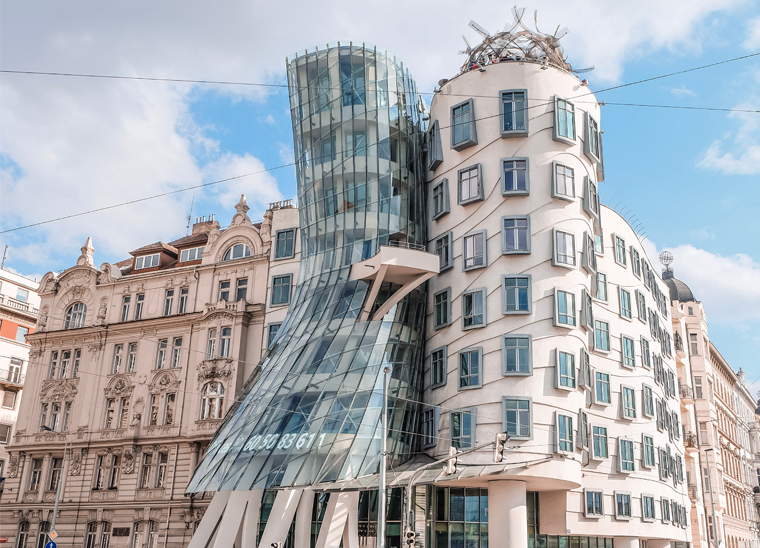
Photo by thewonderalice
Prague is renowned for its magnificent architecture, from the Baroque splendor of St. Nicholas’ Church to the high-tech architecture of Zizkov TV Tower, with its giant metal babies climbing its frame. However, its most unusual architectural offering is that of The Dancing House on the Rasinovo Embankment.
An interesting history surrounds the site where the Nationale Nederlanden building, as it is formally known, stands. The previous building was destroyed by the Allies at the end of World War II. The site stood empty during the Communist era, but writer and philosopher, Václav Havel, who later became president of the Czech Republic, had a plan. He wanted a new building that leaned out over the crossroads to represent democracy as the country evolved. The Dutch company who bought the building heard of Havel’s idea, and merged it with their own for a modern headquarters designed by an internationally accomplished architect, so Frank Gehry was brought in.
The result is a postmodern masterpiece with 99 alternative shaped façade panels with two front towers that resemble a dancing couple. Once nicknamed “Fred and Ginger” after Astaire and Rogers, now it has become “The Dancing House” with its own identity in the city. Visitors can admire it from the outside, take in the outstanding views across Prague from its rooftop terrace or explore the art gallery on the ground floor. Luxury Gold guests begin the Harmony of Central Europe tour in Prague making it easy to add it to your itinerary.
Guggenheim Museum, Bilbao
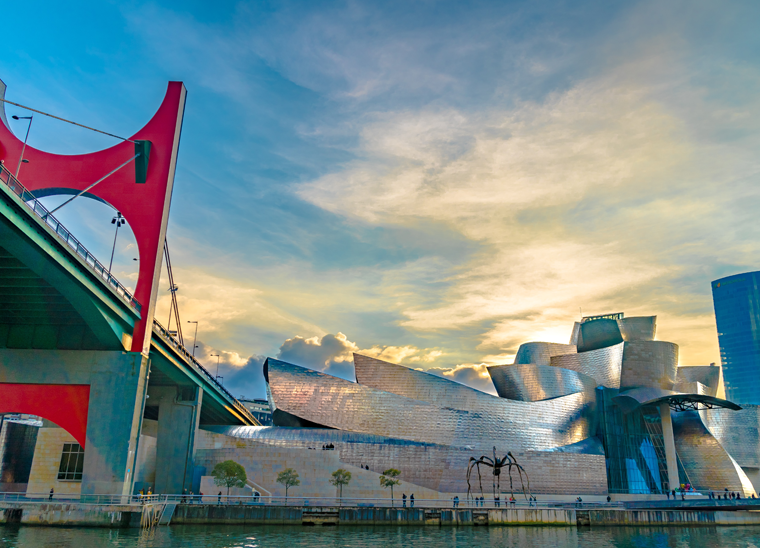
Photo by Willian Juste de Vasconcello
Another audacious design by the renowned Frank Gehry, the Guggenheim Bilbao sits on the bank of the Nervion river. When the influential architect first presented his plans, he used rolled up paper taped together to demonstrate the image he imagined for the museum. In fact, conventional construction methods would have prevented his dream from becoming a reality. It was only with advanced aerospace software that it became possible. The result is an iridescent swirling sculpture that curves along the riverside, both a complement to the city and a bold statement in itself.
The seeming chaos of the building is resolved inside where cathedral-like ceilings and ever-changing light work perfectly for the galleries housed within. In fact, it is easy to move around to the rooms of different sizes and appreciate how functional this astounding form is. However, the true beauty of this unusual architecture is found when viewing it from the outside, seeing how the exceptionally thin titanium sheets reflect the weather and light. Qualified guides are available at the Guggenheim to take you on a special tour.
The Guggenheim Museum Bilbao took four years to complete and was opened to the public in 1997. It was a symbol of the cultural rebirth of the city and has grown to be a must-visit for art lovers visiting the city. It’s definitely worth adding a day or two onto your Spain & Portugal In Style tour to check out the Guggenheim and there are other modern architectural delights in the city to be discovered too.
The Hundertwasser House, Vienna
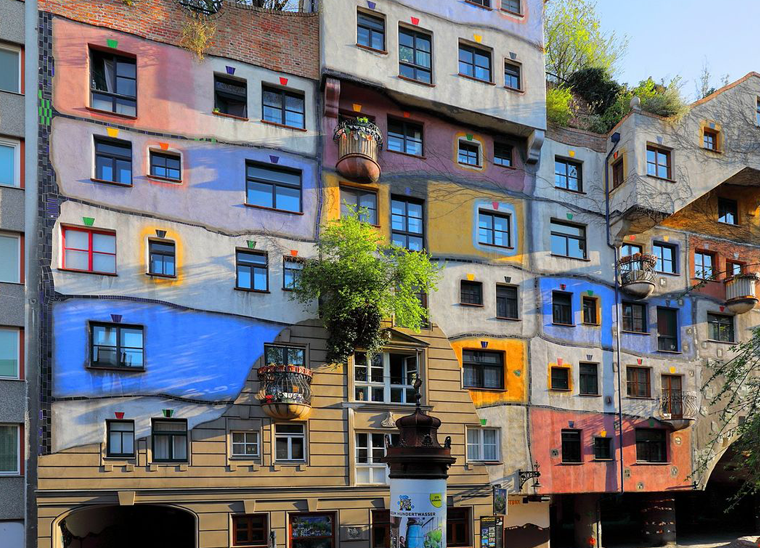
Photo by widewalls.ch
Completed between 1983 – 1985, this residential building is the creation of visionary artist and architect, Friedensreich Hundertwasser, who wanted to prove that more harmony can be found between nature and architecture. He saw it as “a conversation with nature … an oasis of humanity,”. It is certainly an eccentric choice for a municipal building, but the 50 apartments within are inhabited to this day and draw many tourists to view the colorful exterior. In fact, when a resident moves into the building, he can choose what color he’d like his exterior to be. It’s a quirky site and unlike anything you’ll find on the other streets of Venice, or indeed any other European city. Hundertwasser didn’t accept payment for the building but extracted a promise from the council that nothing ugly would ever be built in place of the building.
When enjoying Vienna Your Way, perhaps take some time out at the kitsch Hundertwasser Village to walk across curved floors, see the unusual fountain and admire the abundance of foliage that springs from the 19 rooftop gardens of the main house. You can even have a drink at the bar under which a stream flows. Fans of Hundertwasser may also like to visit the KunstHausWien just five minutes away, which showcases more of the artist’s typical style.
The keen environmentalist is also behind the golden domed-municipal waste incineration plant, Spittelau, which looks like something straight off a cartoon movie set.
Casa Battló, Barcelona
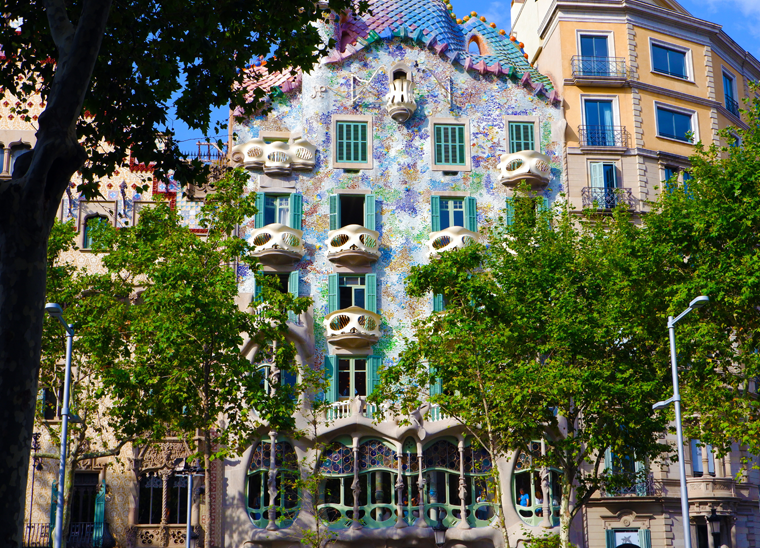
Photo by Ruggiero Calabrese
Those embarking on the Spain & Portugal In Style tour will likely pay a visit to the famous La Sagrada Familia, Gaudi’s unfinished basilica in Barcelona. However, the genius architect has other remarkable gems well worth visiting within the city. One of these being Casa Battlo at 43 Paseo de Gracia, also known as the Illa de la Discòrdia, due to the irreverent buildings that line this boulevard.
Originally owned by prominent businessman Josep Battlo y Casanovas, the house was initially scheduled for demolition, but Gaudi’s ambitious plans removed that need. The Catalan architect managed to redesign the entire façade as well as the interiors, creating a highly functional and beautiful piece of liveable art. The house has gained many nicknames from locals, including “House of Bones”, which some associate with the skeletal appearance of the frontage. The roof looks like a dragon, and there’s a textural harmony to the discs and glass that decorates the façade that recalls the works of impressionist, Claude Monet.
In 2005, Casa Battlo was designated a UNESCO World Heritage Site and cultural guided tours are offered to guests who want to immerse themselves in Gaudi’s dreamlike, yet practical design. It’s possible to visit the noble floor, the attic and the terrace, and your Traveling Concierge would be happy to organize a guided tour of this unusual architectural wonder.
The City of Arts and Sciences, Valencia
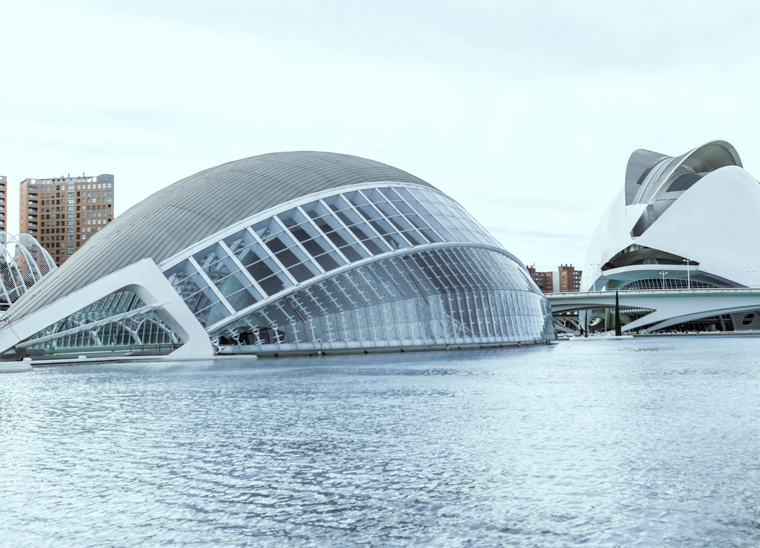
Photo by Ana Abad
Those hungry for architecture usually head to Barcelona and Granada, but the often overlooked city of Valencia has plenty of amazing buildings, from the Gothic 15th century Silk Market to the attractive North Train Station. However, the City of Arts and Sciences is a futuristic paradise and a must-see for those interested in architecture, particularly the work of Santiago Calatrava, Valencian engineer, sculptor and architect.
A collection of buildings rather than just a singular monument, the City of Arts and Sciences is the largest cultural and scientific complex of its kind in Europe. Located in the former bed of the river Turia, Calatrava decided to make water a major element in the design, also making it a mirror for the unusual architecture of the buildings. Each construction is breathtaking in its form, from the curved Oceanografic, which houses Europe’s largest aquarium to the towering L’Agora, where the Valencia Open tennis tournament was held. It’s arguable which edifice creates the most spectacle but the opera house, Palau de les Arts Reina Sofia is an exquisite monument of cantilevered steel covered in white trencadis, a ceramic shard mosaic favored by predecessor Gaudi.
Guests traveling on Spain & Portugal In Style will reach Valencia on Day 3 on their tour, and we recommend taking some time to explore the City of Arts and Sciences.
Krzywy Domek, Sopot
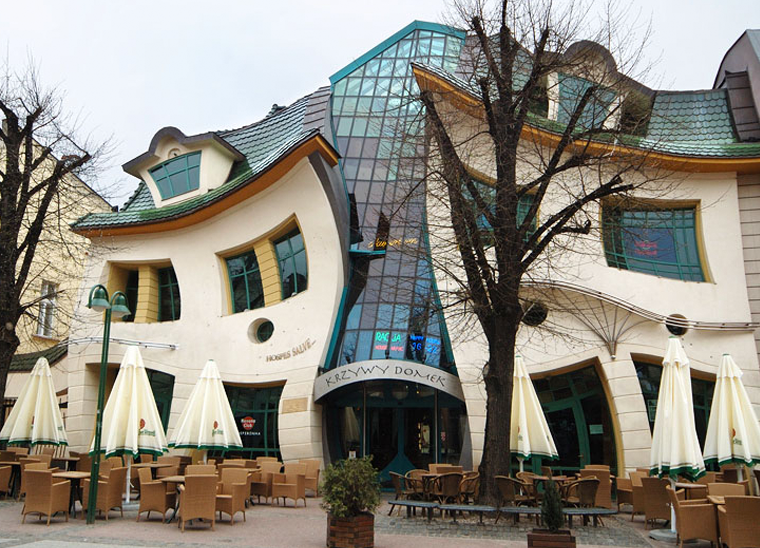
Photo by idesignarch
Poland is known for the Brutalist architecture that is prevalent across its cities, but Krzywy Domek is a far cry from that. The name translates as crooked house, which is fitting for this cartoonish commercial building. The design inspiration came from the paintings of Jan Marcin Szancer and Per Dahlberg, Polish illustrators, but the Szotynscy & Zaleski team brought it to life in 2004.
Situated just by the corner of Monte Cassino Street and Morska Street, Krzywy Domek houses salons, stores and a radio station. It’s fascinating because no matter how long you look at it, it’s still difficult to know how it works! Polish people even have a joke that if you’ve been out enjoying their specialty Zubrowska and the building appears normal to you, it’s time to call it a night.
Krzywy Domek also contains a Wall of Fame with signatures from famous Polish celebrities. If you’d like to spend a few more days exploring Poland after the Harmony of Central Europe tour ends in Warsaw, then add Sopot and this postmodern spectacle to your list.
Book Your Own Tailor-Made Luxury Tour
While this list is by no means exhaustive, we hope these examples of unusual archietcture provide some inspiration for your next European tour with Luxury Gold. Remember, we also offer Tailor-Made Group tours, so if you’d like a guided tour to take in the most interesting architectural sights in Europe, we can design a journey just for your group.



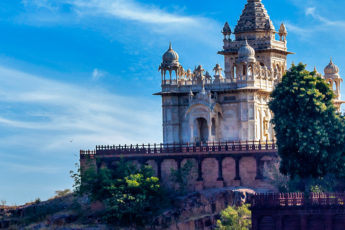
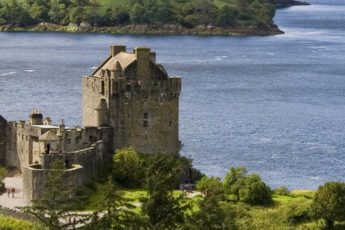





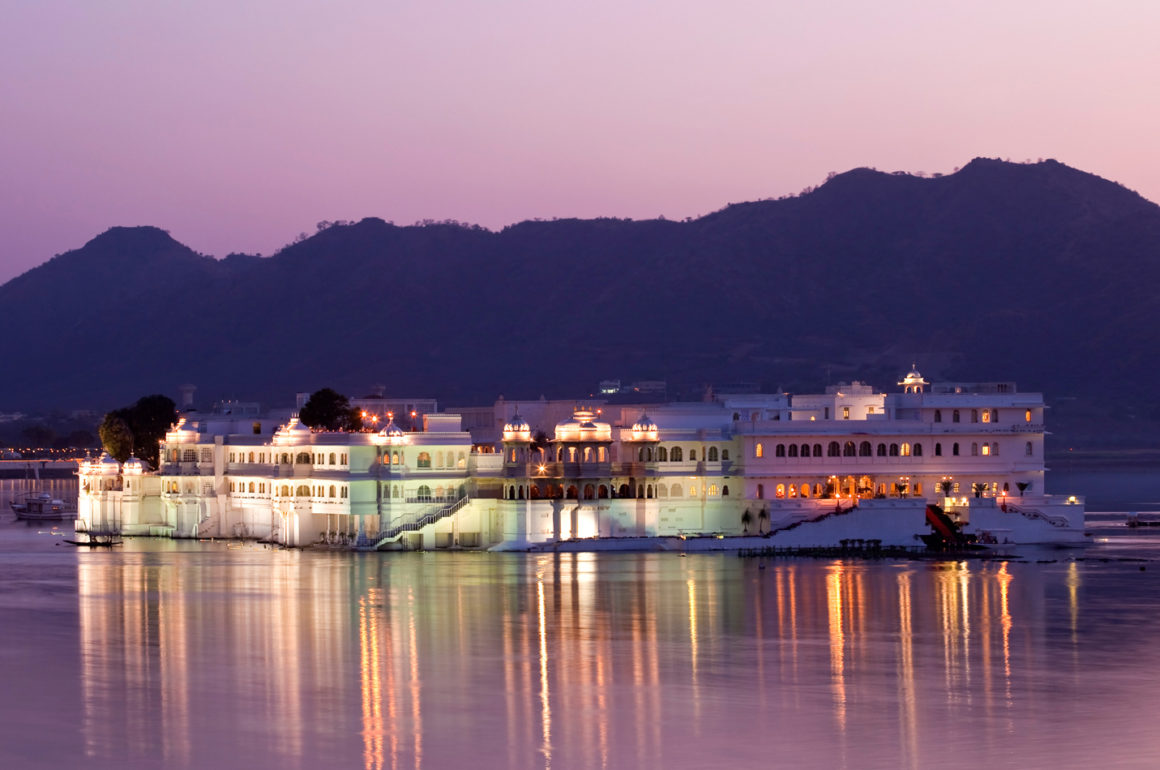
Leave a Comment